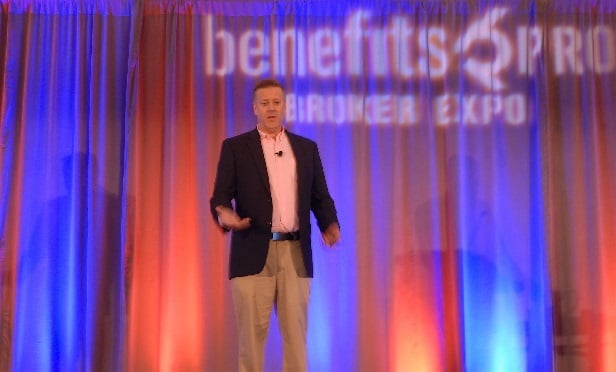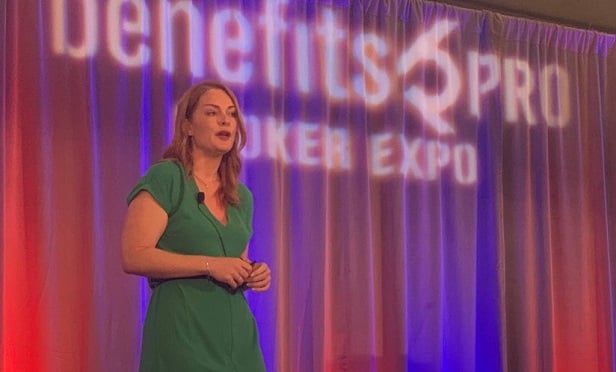 During the closing BEN Talks at the BenefitsPRO Broker Expo, Rachel Miner shared details and photos about her son's medical journey. (Photo: Thomas Phillips/ALM)
During the closing BEN Talks at the BenefitsPRO Broker Expo, Rachel Miner shared details and photos about her son's medical journey. (Photo: Thomas Phillips/ALM)
Reducing health care costs for employers and improving care outcomes has become the core of benefits brokers' business, so much so that they've become a driving force in the disruption and reform of the health care industry. But for some, it's more than just numbers, results and happy clients; it's personal.
In the closing “BEN” Talks at this year's BenefitsPRO Broker Expo, three industry professionals shared their “Why.” Thrive Benefits' Rachel Miner, The Benefit Group's Jim Blacheck and E Powered Benefits' Emma Passe shared their personal stories, offering just a glimpse of what drives them to do what they do every day.
“If you don't feel like something needs to change, you haven't had that personal experience,” Miner said. “I would implore you to use these types of stories to fuel your clients. At the end of the day, the thing that matters the most is the employee experience.”
Here are their three stories, though you needn't look far to hear others — many in the industry have reached out to share their own experiences in the week following the BEN Talks.
Who does the health care system serve?
 (Photo: Thomas Phillips/ALM)
(Photo: Thomas Phillips/ALM)For Miner, it all started with the birth of her second child. “When we were pregnant with Jack, we found out we had soft markers for Down Syndrome,” she said. They would later find out Jack did not have Downs, but he would experience other health issues. “That was just the beginning of our health care journey. What I would classify as a very lonely, frustrating journey.”
As a baby, Jack was prone to illness, Miner said, more so than his older sister. He went to the doctor often, and while Miner loved the relationship she had with the independent pediatric practice in Buffalo, New York, things changed when they moved to Charlotte, North Carolina. “Almost every pediatric practice in Charlotte was affiliated with a system,” Miner said. “We got referred to a boatload of specialists. What that means for Jack is that Jack has very fragmented care and what I don't think is a very good experience.”
Related: 4 requirements for what today's 'health systems' should be
Health care systems are growing larger and more common, and while that might be good for the bottom line, many, including Miner, worry that it comes at the cost of the patient experience. “Our health care system has failed us in a lot of ways,” Miner said. “Over the past six years, I've felt so destitute. As a 12 month old, Jack had to get bloodwork all the time. I used to bribe him with donuts.”
When Jack was two, he got very sick, losing eight pounds and eventually being hospitalized for eight days, at a cost of nearly $70,000. “I asked the first day if Jack could have mono,” Miner recalled, but she was brushed off by the doctor — an all too common occurrence over the course of her son's care. “The fifth day we were there, they did a mono test. Mono tests cost $22. My son had mono.”
Another example: Jack's allergies, for which he had to receive 73 shots as part of a battery of diagnostic testing. “Our allergist told us that one of the widest-used practices in other countries is something called SLIT therapy,” Miner said. “Putting drops of an allergen under your tongue, the body absorbs it, develops defenses and antibodies. It is the widest used practice in all other Tier 1 countries. But insurance doesn't cover it here; pharma companies can't make any money on it.”
In a health care system focused on profits, Miner says it's fallen on her to be an advocate for her son and ensure he gets the necessary continuity of care. “As a parent, I can't tell you the amount of time, because our system was so broken, that I've sat up at night and googled and researched and cried.”
Miner has become an expert in all things related to her son's care. As a benefits professional, she's also well-versed in health care consumer literacy and navigating the health care system. “I'm a very educated consumer,” she said. “I use a lot of advocacy apps, I believe in transparency. And it's confusing to me. If it's confusing to me, how do you think a person making $12 per hour who didn't graduate high school feels?”
Your company's most valuable asset
 (Photo: Charles Garnar/ALM)
(Photo: Charles Garnar/ALM)The Benefits Group's Jim Blachek shared a story that strikes at the heart of the entire concept of employee benefits.
In 2013, business was booming. “We had just come off a great 2012,” Blachek recalled. “My firm had maxed out our carrier contracts and our bonuses. We had killed our revenue goals.”
During a celebratory snowmobiling trip into the north woods of Canada, however, Blachek got some news that would change his life and make him forget all about those revenue goals. “At 11 PM at night, I hear a knock on the door,” he recalled. “I knew it wasn't good news.”
His son had passed away suddenly and unexpectedly, and Blachek reacted as any grieving parent would. “For the next two and a half years, I was my company's worst employee. I wasn't present mentally, physically or emotionally. If you'd asked me what was happening, I couldn't have told you.”
And yet, his company not only survived, it thrived, thanks to the hard work, loyalty and dedication of his employees. “When I stepped off, my employees stepped up,” he said. “They saved my business. I now know, my employees are my most valuable asset.”
This is a lesson for all business owners. “Without employees, you have no business,” Blachek said. “Without the employers we work with, you have no book of business. I feel so strongly about this change, that it's now my mission and purpose to bring better quality of care and access to employees. The employee is ultimately the one who needs to win, and when we do that, the employer wins.”
It's this perspective that should be driving employee benefit decisions, not just a focus on keeping costs down. “What have we done to the employees?” he asked. “We've taken deductibles and jacked them up: $1,000, $2,000, $3,000. We've created a population that's functionally uninsured. They have insurance, they just can't afford to use it.
“We've brought in new tools and strategies, but they haven't worked,” he continued. “We as advisors and brokers, don't really understand how to implement them and educate employees on how to use them. And we've compounded the problem of unaffordable health care by jading the employer. Are these tools free? Did we just add cost? We failed.”
Worse yet, brokers have conditioned employers to be okay with these failures, to just accept yearly spending increases and move on. “If we continue to foist failure onto our clients, we're crushing their bottom lines, and we're crushing the employees' financial future,” he said. “When you know that employees are the key to your business, your business is the key that drives your client's success.”
Taking on a national epidemic
 (Photo: Thomas Phillips/ALM)
(Photo: Thomas Phillips/ALM)At one point, Emma Passe was the type of health care consumer employers would prefer not to employee, seeing doctors frequently for issues such as poor cholesterol, pre-diabetes and sleep apnea. All complications of being obese. And while obesity is a national epidemic in the U.S., it's not the one Passe discussed.
Passe switched from a treatment-driven health care strategy to prevention, utilizing health coaching to lose 140 pounds over the course of 18 months. “Anyone who has experienced that knows it comes with some consequences,” she said. “Some of my abdominal muscles had shifted. I needed a medical procedure to correct the muscles in my abdomen and also get rid of some of the skin on my stomach.”
The procedure was going to be painful, requiring an incision that ran the width of her stomach. But Passe stressed repeatedly to her surgeon that she did not want opioids for the pain. “I have a very low tolerance for pain medications and a high tolerance for pain,” she said. “I explained this to my surgeon and got a lot of pushback. I talked to him at great length about my aversion to opioids, but more than that, I work in this industry, and I am working tirelessly at the height of an opioid epidemic. And I know how quickly it goes from pain management to addiction.”
In fact, Passe spoke out so strongly that the hospital listed narcotics in her medical chart as an allergy. But that didn't stop the nurses from giving them to her, not once but twice. “When I was in the recovery room, a nurse administered Dilaudid through my IV,” Passe recalled. “Because my chart notes I have an aversion, she added Zofran to cancel out the nauseating effect.”
Conscious and recovering in her hospital room, Passe was better able to advocate for her pain management. “Nurses would come in and ask about my pain level,” she said. ”I would say it's about a seven. They'd say, 'let me give you something.' I had to say no at least a dozen times.”
She later received a second round of Dilaudid and Zofran while she was sleeping.
Passe's recovery continued at home, without narcotics. “Three days after I'd been discharged, I had a pain in my right calf,” she said. As the pain continued, she called her surgeon, who instructed her to go to the emergency room, where she would eventually be diagnosed with a blood clot that was treated before any complications could develop.
But what would have happened, Passe posited, if she hadn't felt the pain? “Had I followed the instructions of every surgeon, nurse and provider and taken the pain medication, would I have felt a pain in my leg? Would I have known it was hurting if I was on a schedule of opioids? Could I have gone to the ER?”
“Losing weight is not that hard,” she continued. “Recovering from surgery is not very hard either. The recovery that is really hard is addiction. And most people who are addicted to an opioid start with a legitimate prescription just like I was given.”
The problem, she said, is that the hospital systems are too focused on earning high marks from their patients in areas like pain management, which improves their quality scores. “But that has nothing to do with quality,” Passe said. “Pain is not a disease. Nobody has ever died from pain.”
Addiction, however, is a disease, and 130 people die every day from overdoses, Passe said. It's something that can and should be changed, and the benefits industry is in a key position to make it happen. “Every one of us in this room has influence over somebody else,” she concluded. “Every single one of us has the opportunity to contribute to positive change in this industry.”
Read more of our Expo coverage:
Complete your profile to continue reading and get FREE access to BenefitsPRO, part of your ALM digital membership.
Your access to unlimited BenefitsPRO content isn’t changing.
Once you are an ALM digital member, you’ll receive:
- Breaking benefits news and analysis, on-site and via our newsletters and custom alerts
- Educational webcasts, white papers, and ebooks from industry thought leaders
- Critical converage of the property casualty insurance and financial advisory markets on our other ALM sites, PropertyCasualty360 and ThinkAdvisor
Already have an account? Sign In Now
© 2025 ALM Global, LLC, All Rights Reserved. Request academic re-use from www.copyright.com. All other uses, submit a request to [email protected]. For more information visit Asset & Logo Licensing.








